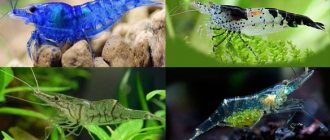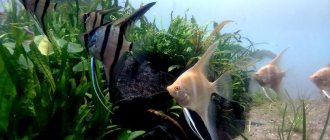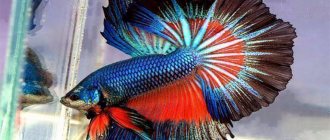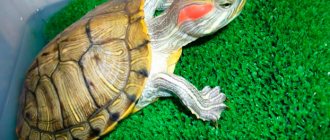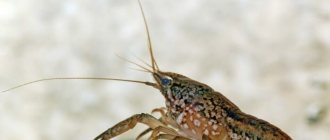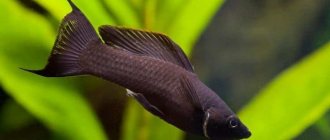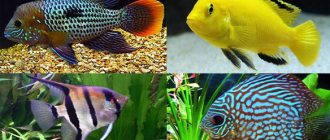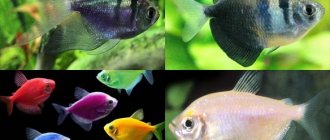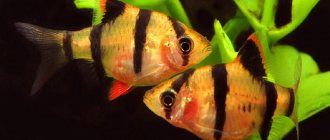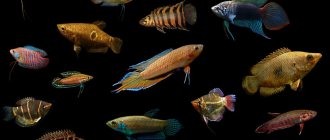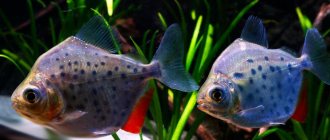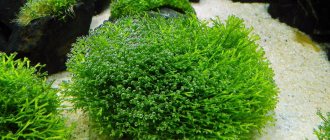Of the many small, bright aquarium fish, gourami are distinguished as the most unpretentious. Unusual appearance, variegation of color and good health - this has made gourami one of the most popular types of domestic fish. The marbled gourami is extremely beautiful. If you are the happy owner of such a scaly pet, then sooner or later you will want to replenish your aquarium. In this case, we recommend that you familiarize yourself with what marbled gourami look like: male and female in the photo, and learn about the basic rules for breeding this species.
Physiological features
The difficult conditions of the natural environment in which wild speciation-forming individuals live were also reflected in the physiological characteristics of the selected Cosby morph. Natural forms of gouramis live in ecosystems with low oxygen levels and poor visibility. To survive in such conditions, the evolutionary process endowed fish with a labyrinthine apparatus and an additional type of receptor.
Thanks to the epibranchial organ, gourami can breathe atmospheric air. This anatomical feature compensates the fish for the lack of oxygen dissolved in water. The labyrinth is located in the expansion of the first gill arch. This cavity is formed by thin plates that are covered with a vascular mucous membrane.
Marbled gouramis are labyrinthine, so they can breathe not only through their gills.
Additional tactile organs are represented in gourami by a pair of processes formed by the first rays of the pectoral fins. With their help, a threader in troubled water:
- feels the bottom;
- looking for food;
- senses the approach of a predator.
The tissues of the filamentous processes are capable of regeneration and, when broken off, grow back over time.
When unfavorable conditions develop, gouramiids are able to remain without water for up to 6-8 hours.
Lifespan
Marbled gouramis live 7–8 years in an aquarium. In wild representatives of the genus in the natural environment, this period is almost half as long.
The lifespan of these beautiful fish is 7-8 years
General information
The marbled crayfish (Procarambus virginalis) is a freshwater crustacean from the Decapod family. Now it can be found in almost every corner of the planet; it has successfully acclimatized in many regions.
Scientists consider the ancestor of the marbled crayfish to be the crayfish Procambarus fallax, common in the southeastern United States. At one time, they became famous aquarium pets because they are interesting exotic animals, and their care is minimal.
The crayfish reproduced well, and then one day in Germany, thousands of kilometers from their historical homeland, individuals with a very beautiful “marble” color were born, which instantly made them even more popular. But the main surprise was ahead: it turned out that these crayfish acquired the ability for parthenogenesis - the development of an embryo without fertilization. That is, all individuals of marbled crayfish are females who are capable of producing offspring that appear through the normal division of an unfertilized cell. In fact, all offspring are clones of the mother. This is the first time such a phenomenon has been observed in decapod crayfish. At first, the new form of crayfish was attributed to the original species - Procambarus fallax, but in 2015 the taxonomy of the marbled crayfish was revised, and it became an independent species - Procarambus virginalis.
Marbled crayfish is able to reproduce without fertilization. This process is called parthenogenesis.
Thanks to its wide distribution in the aquarium hobby and regular introductions from domestic conditions into the wild, this species began its “victorious” march across the planet. At first these were European countries, and later it was discovered in Asia and Africa.
Thanks to its amazing adaptability, the marbled crayfish has become an environmental problem in some countries, as it successfully competes with local species and displaces them from their usual habitats. To reproduce, it needs only one individual, unlike other relatives, so it can quickly capture new territories.
For this reason, the import and sale of marbled crayfish is prohibited in many countries.
Habitat
Blue gouramis (cosby species) inhabit Southeast Asia. They live in the flooded lowlands of the island of Sumatra:
- swamps;
- ditches;
- streams;
- pits;
- irrigation canals;
- rice fields.
Tropical threadworms prefer natural, stagnant bodies of water with abundant vegetation and feed on bioplankton and insects. They occupy the middle and surface layers in order to have time to capture atmospheric air, thus compensating for the lack of oxygen.
Gourami live in rivers, streams, ditches and lakes of Southeast Asia.
Thread-bearing gouramis are able to hunt insects flying near the surface of a reservoir. They knock down small midges with a stream of water from their mouths and then pick up the fallen prey.
How to determine gender
Individuals become fully sexually mature at the age of six months (for reference, they live from four to six years). Some breeders claim that it is possible to determine gender by behavior, but such opinions are most often erroneous. Gourami are peaceful, and the male begins to show aggression after spawning, protecting the offspring - that is, when sex determination for reproduction no longer becomes relevant.
You can distinguish a female from a male by external signs. So, boys have an elongated, pointed fin on their back. This feature is characteristic of the entire taxonomic group: any gourami belongs to the macropod family. Some species, for example, thread-bearing gourami of the genus Trichogaster, have very long dorsal fins. Males are also distinguished by brighter colors (especially during the breeding season) and a narrower body.
Females, accordingly, are fuller, with small rounded dorsal and anal fins. Sometimes females are smaller than males, but not always. Such differences are more individual than gender characteristics.
Maintenance and care
Marbled gouramis are unpretentious aquarium fish, since genetically they have inherited a sufficient reserve of endurance from their ancestors. To keep them you need a small herbalist or a multi-species aquarium with shelters. Like all threadfish, cosby fish are undemanding when it comes to food and water composition.
Aquarium
Marbled Cosbys are kept in a 30-40 liter frame or frameless aquarium. For a couple of fish, 15 liters of water is enough. Spacious structures promote fish growth and swimming activity, and reduce territorial aggression in males.
To keep gourami you need a spacious aquarium
The aquarium is equipped with a light lid, which will level the temperature of the gaseous and aqueous environment. This way the fish will swallow warm, non-cold atmospheric air under the lid.
Water parameters
The aquarium is not completely filled with settled water, leaving about 8 cm to the edge. Marbled gouramis are undemanding to the composition of the environment, but are sensitive to its temperature, as they are heat-loving fish.
| Optimal physical and chemical water parameters for keeping marbled gourami | |
| Acidity | 6.5–7.5 pH |
| Rigidity | 6-20 Gh |
| Temperature | 22–28 °C |
Thread carriers love the “old” environment in which the nitrogen cycle has taken place. Fresh, settled water increases aggression in males.
Filter and aeration
Since marbled gouramis have a well-developed labyrinth organ, they do not need a compressor to saturate the water with oxygen. It is advisable to equip the aquarium with filter elements to reduce the level of organic pollutants in the habitat. It is important to take into account that Cosby does not like undercurrents. It is better to choose low-power filter models and direct the flow of water into a dead space.
Reproduction
Marbled gouramis are spawn-laying fish. They reproduce easily and do not require hormonal stimulation. You need to start breeding Cosby by setting up a spawning ground with a large water surface. For these purposes, you need a spacious structure with a volume of about 50 liters. The reservoir is filled with water at a level of 15 cm and a lot of vegetation is placed in it.
It is advisable that the spawning aquarium have a volume of at least 50 liters
In order for the fish to reproduce well, they begin to be intensively fed with live protein food and imitate the onset of spring, increasing the temperature of the environment.
What to feed marbled gourami?
Marbled gouramis, like all their other species, are unpretentious in nutrition - they are ready to absorb absolutely any food, even midges and other insects flying over the aquarium. It is important to adhere to the main requirement - the diet should be varied, since without this, fish grow and reproduce poorly.
What food to give:
- insect larvae;
- frozen food - brine shrimp, tubifex, bloodworms, etc.;
- planaria, hydra;
- chopped dietary meat;
- leaves from dandelion, wood lice, lettuce;
- ready-made food - plates, flakes, granules, etc.
The feeding regime is not strict - it is enough to give food once a day and even every other day. If the aquarist leaves for 1-2 weeks, the fish will not die, because they are able to live this time without food.
There are a number of universal feeds, for example:
- TetraPro Energy. Intended for tropical animals, which include the marbled gourami. It comes in the form of chips that need to be crushed. In addition to nutrients, it contains energy concentrates to increase activity.
- TetraMin. It is a universal and balanced food in the form of flakes containing all the necessary beneficial elements.
- TetraPhyll Granules. It is produced in the form of granules that sink slowly. The basis is plant food.
There are other foods that are selected individually - depending on the needs of the fish, the financial capabilities of the aquarist, and ease of use.
Diseases and prevention
Marbled gouramis have good immunity and, under favorable conditions, rarely get sick.
With insufficient care and neglect of quarantine measures, even the most persistent species of aquarium fish will be susceptible to pathological conditions.
Infections to which the marbled gourami is prone include:
- lymphocystosis;
- pseudomonosis;
- aeromonosis
Weakened individuals are more likely to get sick. To ensure that the level of immune protection does not decrease, it is necessary to maintain a comfortable temperature of the water in the aquarium, avoid sudden changes in temperature and feed the Cosby moderately, adhering to a balanced diet.
Proper care and appropriate water parameters are the key to the health and longevity of aquarium fish
Excess food, as well as too little, can negatively affect the health of fish.
To prevent invasive and infectious diseases, it is recommended to wash live food well and deep freeze it. This will reduce the likelihood of introducing pathogens and parasites into the aquarium.
Coloring is one of the main indicators of the condition of the fish. The bright color of the integument is an indicator of good health.
Lymphocystosis
Chronic viral disease caused by Lymphocystivirus. Small and medium-sized warts and irregularly shaped nodules appear on the integument of infected individuals. On lightly colored fabrics, such formations are often gray or cream in color. Pigmented areas of the body may take on a different shade. The growth forms within 24 hours and remains on the integument for about a week.
Symptoms of lymphocystosis in gourami
Infection occurs through contact with an infected animal. Traumatic factors aggravate the process.
Most often, lymphocystosis goes away without treatment in 3-6 weeks, since there is no effective therapy for this disease. In this case, it is necessary to ensure that the water in the aquarium fully complies with the physical and chemical parameters, and that the food is of high quality and enriched with a vitamin-mineral complex. In valuable individuals, nodular formations are sometimes cauterized with electric current.
Quarantine
Quarantine measures reduce the risk of infection in the aquarium. This allows the disease to be diagnosed and monitored in isolated fish.
If there are unusual changes in appearance or behavior, the fish should be transferred to another tank.
For quarantine, use a separate 15-20 liter tank, where a new or presumably unhealthy individual will be kept under observation for two weeks or more.
The following preventive antiseptics are introduced into the quarantine area every day for 10-20 minutes:
- 2% saline solutions - 2 tsp per 1 liter of water. table salt;
- malachite green for fish – 6 mg per 10 liters of water;
- a weak solution of potassium permanganate or brilliant green - a volume is added to slightly tint the water;
- methylene blue for fish – 25 ml per 10 l;
- bicillin-5 – 50,000 BD per 10 liters of water.
2% saline solution
Malachite green preparation
Weak solution of potassium permanganate
Methylene blue drug
The drug Bicillin-5
After antiseptic procedures, the solution is poured out and the fish is kept in fresh, clean water.
After the quarantine period has expired and if there are no signs of disease, the isolated individual is transferred to a common aquarium.
Price
Marbled gourami are widely available for sale and are sold at different prices in markets, pet stores, on websites where private advertisements are posted, and online trading platforms. Most often, the cost is determined by the size of the individual.
Average price of marble gourami in the online store:
- 3 cm – 95 RUR;
- 5 cm – 130 rub.;
- 6.5 cm – 210 rub.;
- 8 cm – 310 rub.
You can purchase thread carriers from private breeders at a lower cost - from 25-30 rubles.
Adviсe
If Cosbys live in an aquarium, then it is important to take into account the characteristics characteristic of the species. This approach will have the most favorable effect on their condition and will reduce the likelihood of stress and illness in fish.
Tips for keeping and breeding marbled gourami:
- If it is not possible to feed gourami a variety of foods, preference should be given to freeze-dried food. Such diets are distinguished by their multicomponent composition and high nutritional value.
- A strong current in an aquarium and trying to cope with it leads to unnecessary physical exertion and can cause stress in the fish. To minimize the movement of water in the tank, the filter is equipped with special nozzles that control the strength of the flow.
- If in a flock there are several females per male, his level of aggression will be lower.
- A large number of hiding places will reduce the number of skirmishes and fights in a multi-species aquarium.
- A portion of fresh, settled water added to the spawning tank is a good stimulant for mating.
- It is better to give bloodworms to fish before spawning. Prey such as daphnia and cyclops predispose breeders to eat their offspring due to the crustaceans' resemblance to larvae. Gourami can mistake their brood for food.
- The fry grows unevenly, so it must be regularly sorted so that strong individuals do not exterminate their weaker counterparts.
Grottoes in the aquarium will protect the fish from aggressive neighbors.
Even if there is a sufficient amount of dissolved oxygen in the water, the gourami will die without access to atmospheric air.
Nutrition
The fry will grow best if you feed ciliates and nauplii of crustaceans. Some aquarists practice feeding boiled egg yolk, but this may not give good results.
Many fish don’t mind eating a regular cucumber.
Adult fish are not picky eaters; moreover, they are not afraid of parasites such as hydra or planaria. Preferable, of course, is live food: bloodworms and tubifex. With appetite, marbled gouramis eat raw meat, if it is finely scraped, as well as finely chopped lettuce or dandelion leaves.
Dry and frozen food can be used, but not as the basis of the diet.
Reviews
Marbled gourami can be recommended to those who are planning to buy an aquarium and have never had experience in keeping fish before. It can withstand the disadvantages of its environment and will forgive a beginner short-term errors in care. The measured and unhurried behavior of gourami in the aquarium allows you to temporarily escape from the daily hustle and bustle and relax, being alone with wildlife.Have you ever kept these fish? Share your impressions about them in the comments.
Compatibility
The compatibility of gourami with other fish is quite high. The marbled gourami gets along well in a common aquarium with peaceful and calm species: angelfish (angelfish), barb fish, rasboras, swordtails, tetras and mollies. Catfish are good neighbors.
Don't get along very well together:
- different types of gourami (for example, marbled gourami with opaline);
- with aggressive discus and eels;
- with guppy;
- with shrimps and crabs.
They don't get along:
- with territorial species - goldfish, parrotfish, cichlids;
- with cockerels;
- with koi carp;
- astronotuses.
